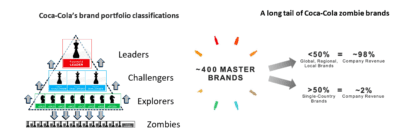By Joanna Seddon, Managing Partner, Presciant
The Coca-Cola brand portfolio is in for a trim, as they give underperforming zombie brands the axe.
Coca-Cola has conducted a thorough brand rationalization study. They classified its brands based on market position and maturity. The top leaders are famous brands such as Coke and Sprite, which are #1 in their markets. Then come the challenger brands with significant share and the potential to grow Int future leaders. This category includes Simply (fast growing) and Minute Maid (potential to invigorate and speed up growth). These are followed by explorers, which are new brands with high potential, such as AHA and Topo Chico. At the bottom come the poor zombie brands –200 hundred walking dead brands with low strategic or growth potential. Those are the parts of the Coca-Cola brand portfolio that will be eliminated.
Coca-Cola is not the first to spectacularly rationalize its brands. Some years ago, Unilever stripped down its brand portfolio from 1600 to around 500 brands. It won’t be the last. Companies tend to go through cycles of brand expansion and proliferation and then burst. The Unilever number has crept up again to around 1,000.
Why do companies such as Coca-Cola and Unilever go on brand cutting sprees?
How does an expanding brand portfolio happen? And does it make sense to constantly be adding brands? Our view is that it shouldn’t, and it doesn’t.
We believe that brand proliferation reflects a lack of understanding of the importance of brand portfolio architecture. This mistake leads companies to miss out on huge opportunities to achieve higher sales and profit growth.
Four main reasons why brand portfolios swell:
- Brand by brand thinking
Responsibilities are allocated and budgets set brand by brand. That’s where the P&L’s sit. Each brand within a portfolio operates in a vacuum. Brand managers pursue individual brand objectives, rather than thinking of the good of the whole.
- Brand portfolio decisions are pushed down
Decision-making about brands is left to individual product groups or markets. Each believes that they have the freedom to invent, name and position new brands at will. The worst offenders are the tech companies. The engineers say: “Look at this great new product (or variation or evolution) I’ve come up with, let’s order pizza and name it over lunch”.
- Brand portfolio decisions are taken short-term
Brand managers are rewarded on the basis of the next quarter’s or the next year’s sales goals. Marketing and innovation budgets are allocated to whatever is most likely to achieve these short-term targets. This dynamic encourages over-experimentation and the pursuit of fads–each with their own names.
- Brand innovation is driven by “small-picture” thinking
The pressure to deliver now forces the focus on whatever will make an immediate difference, even if its small. Initiatives which will take time to produce results are not pursued, even if their potential impact is immense.
Brand proliferation can put the business at risk and make killing zombie brands necessary
Marketing spend is fragmented across too many brands and becomes ineffective. Investment in innovation is split across too many initiatives, with not enough being spent to allow any to become breakthrough. The company loses its relevance and competitive edge, under attack both from major competitors and disruptors. It is forced back into a defensive position. It is when this weakened position is recognized that the drastic brand portfolio pruning reaction occurs.
Will killing zombie brands benefit the Coca-Cola brand portfolio?
Yes, in the short-term. Killing 200 smaller and underperforming zombie brands will allow the company to focus on big brands and those with strategic or growth potential. The company can spend to reinvigorate Minute-Maid, develop Costa Coffee, and invest behind cool brands such as Topo Chico. The discontinued brands include well-known names such as Odwalla and Tab. Some healthier, more future-oriented brands may also be at risk : Coke Life ,which includes natural zero calorie sweetener stevia (aka Truvia), and potentially Dasani. Others being sacrificed have strong local constituencies: fans of the almost 100-year-old cult classic Northern Neck Ginger Ale, a regional Virginia brand are already on the warpath, determined to save it. It Is possible Coca-Cola can wring a last bit of value out of some brands by selling them to Investors.
The dangers of discontinuing brands in a brand rationalization initiative
Brand rationalization and killing zombie brands brings its own dangers.
- A drop in sales: Short-term, revenues and profits fall, as products are killed off and businesses sold.
- Competitor disruption:Abandoning parts of the market creates space for competitors to enter. Future opportunities may be missed and grabbed by others —PepsiCo for example, has launched Driftwell, which helps you sleep.
- Existing products drown out new brands:Brand portfolio trimming can cause potential customers to overlook innovative new products. New brands and sub-brands can play an important part in signaling innovation and change in strategy. Stopping brand proliferation shouldn’t completely stop the creation of new brands. It must be done thoughtfully with the big picture In mind so as not to bring forth zombie brands of the future
How to avoid Coca-Cola’s zombie problem
Avoiding the cycle of brand portfolio boom and bust has five parts:
- Look ahead: Start from the future and work back to the present. Identify the biggest future market opportunities.
- Start from customer needs: Make customer needs within the category the starting point for a decision to create a brand. Determine what products are needed to meet them.
- Take a portfolio point of view: Look at your brands through a portfolio lens. See which brands fit best with the future market opportunities. Identify gaps where you don’t have brands.
- Balance long term and short term: Split your marketing and innovation budgets between building the brands you need for the longer term and supporting the current brands
- Prioritize, prioritize, prioritize:You may not need to kill non-priority brands. You can let them fade away.

For more information, please visit: www.presciant.com.

















